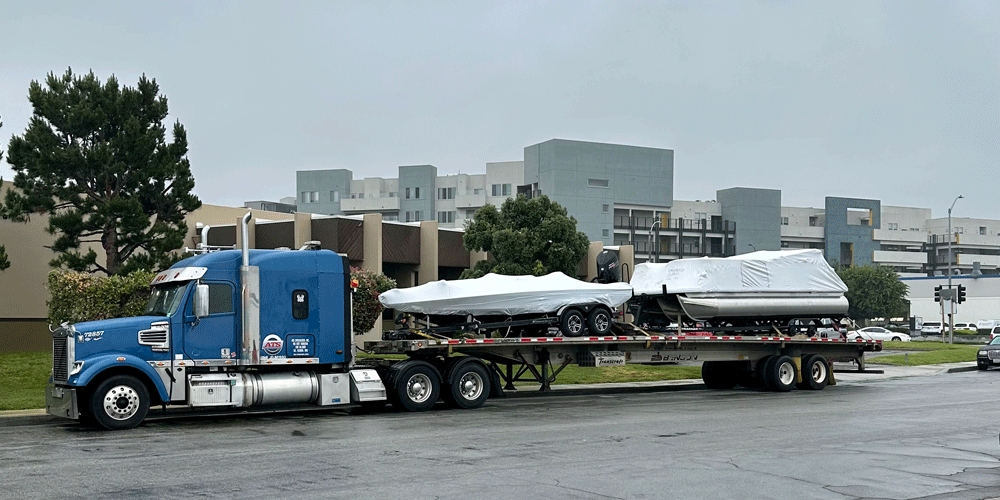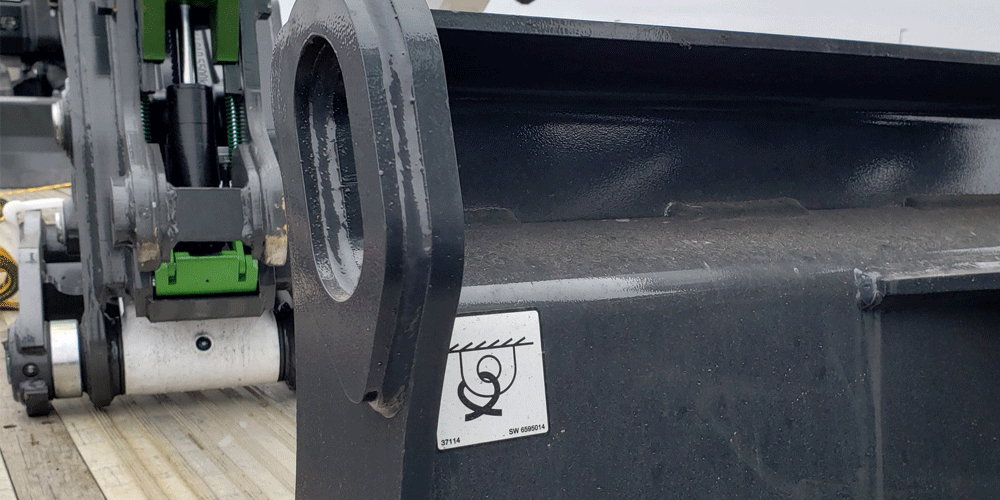Cargo Securement Tips [Do’s, Don’ts and Tips for Securing Common Freight]
Charlie has been with ATS for nearly two decades. He wears many hats at ATS as the safety instructor for flatbed cargo securement. He takes drivers through flatbed securement training in orientation and is the point person for drivers who have questions on the road. He’s also able to answer any hazmat questions drivers may have.
Being a truck driver is no doubt a tough job. You have to be focused 100 percent of the time. Looking away from the road for just a few seconds can cause a bad accident.
Then you have to take into consideration the other difficult aspects of your job, like securing your freight. If cargo isn’t properly secured, it can shift on your trailer or fall off entirely — damaging the freight and harming anyone who may be driving around you.
Here at Anderson Trucking Service (ATS), I’m a cargo securement specialist. Each week, I take new drivers in orientation through classroom and hands-on load securement training so they’re prepared to drive in the flatbed division. Some drivers have never secured a load before and some come to us with previous experience.
Often, I work with drivers who are not only new to flatbedding, but they’re also fairly new to trucking itself. It’s not just tie-downs they’re learning — they’re still getting the hang of how to operate a truck.
Securement is a lot to learn, and it’s certainly not for everyone. If you just want to get in the truck and go, it’s probably not the right path for you.
That being said, we could all use a few extra reminders, tips and tricks to help us succeed at our jobs. The following are some basic tips that I teach my drivers in class each week. I’ll also help you by providing some basic information on how to haul general freight, like construction equipment, lumber and coils.
This information will prevent you from receiving cargo claims or accidents that are both costly for you and your trucking company.
Tip #1: Start with Dimensions
Before you start pulling out your chains, straps, tarps and other tools, take a step back. What are you hauling? Are there any specific customer requirements? You may have to tarp or secure the freight a certain way.
Then, determine the cargo’s length and weight and go from there. Once you know your freight’s length and weight dimensions, you can decide what type of securements you’ll use and where to place them.

Tip #2: Calculate Minimums
Each cargo securement (or tie-down) you use, whether it’s a strap or a chain, has a working load limit (WLL). This is how much weight it’s rated to support and secure.
Once you determine the weight of your load, you can calculate the minimum number of tie-downs you need on the load. For example, if your load is 15,000 pounds and each strap is rated for 5,500 pounds, you’ll need three chains to support the weight of the load.
There are different sizes of chains and straps. The size of the securement you should use is dependent upon how heavy your freight is. A Grade 7 chain measuring 5/16 inches can support 4,700 pounds. A Grade 7 chain measuring ⅜ inches is rated for 6,600 pounds.
Balance quantity and strength when making your decision about securements. If you’re only hauling 10,000 or 20,000 pounds, smaller chains will work. If you’re hauling 20,000 or 30,000 pounds or more, choosing a stronger chain is a better choice. Drivers in the heavy haul division use ½ inch chains that are rated for 11,300 pounds.
While you could always use the smaller chains on heavier loads if you wanted, you’ll have to use a lot more chains — which will take a lot more work. It’s impractical.
When in doubt, over-secure your freight. There’s no top end to how many securements you can use. If you want to add an extra strap or chain for some extra peace of mind, you certainly can. Just be sure you know the minimum number of securements you need to ensure you meet (and hopefully exceed) requirements set by the Department of Transportation (DOT).
Tip #3: Use the Right Securements
Sometimes a driver will use both chains and straps to secure their cargo, but it’s more common to use one or the other.
When deciding which securement device you’ll use, it often comes down to the cargo’s weight, whether it has a manufactured securement point(s) and whether it can be damaged by securements.
When you look at the freight, determine if you can secure with direct securement or if it’ll have to be an indirect securement. A direct securement becomes possible when there’s a manufactured securement point on the freight itself you can secure to. Oftentimes, construction equipment (for instance, an excavator) has a manufactured securement point for tie-downs. You’ll know if it’s a manufactured securement point because it’ll have a sticker next to it (see photo below for reference).

If there isn’t a securement point on the freight, you’ll be using indirect securements and placing tie-downs over the freight from one side of the trailer to the other side.
Typically, with direct securements, you’ll use chains. With indirect securements, you’ll more often than not be using straps. This is often the case because chains can damage freight. For instance, if you use chains for an indirect securement, you could damage the freight by scratching the paint or putting a dent in it. You should never damage the cargo, which will result in a cargo claim from the customer.
Tip #4: Choose Your Securement Points
Putting a securement in the wrong place can result in completely collapsing the freight and destroying its structure. Anything that can be damaged or crushed by securements shouldn’t be used as a securement point.
Again, you should never risk damaging the freight. Choose strong securement points where you won’t cause any damage. Look for areas of support.
Never place a securement over a weak point on your cargo. Examples of weak points include electrical lines, hydraulic lines, hydraulic cylinders and anything similar. Certain equipment, like agriculture equipment, is made with lightweight tin metal. This can be easily damaged and shouldn’t be used as a securement point.
Follow customer requirements for the location of securements, too. If you’re unsure about where to place your securements, first start by asking the customer for help. If that doesn’t work, reach out to your company for assistance.
Tip #5: Protect the Freight and Securements with Padding
Just like you need to protect the freight from damage, you also need to protect your securements.
If you’re securing a sharp object, like granite, it can cut through straps. One hard stop can cause the straps to rub against the granite so hard that they snap.
Use padding, like old straps, carpet protectors or rubber pieces, to put a barrier between your cargo and your securements.
You may need to do this if you’re worried about damaging your tie-downs or you think your tie-downs could damage your cargo. I see countless claims for scratched paint on brand-new agriculture equipment — all of which could’ve been prevented.
Customers may request padding is used as well.
Tip #6: Use the Right Pressure
There’s a delicate balance between the right amount of pressure and too much pressure. Securing freight is like that. Too tight and you damage the freight. Too loose and you can lose the freight entirely.
Figuring this out definitely comes with time and practice, but there are a few tips that can help you excel in this area early on in your flatbedding journey.
For starters, know what you’re securing. How tight a securement can be and needs to be is relative to the product. If you’re securing a very light product with some give, like foam board, over-securing it can ruin the product by crushing it or collapsing it. The wrong location and too much pressure can wreak havoc on the product.
Some drivers feel as if they have to have their securements as tight as possible for them to work. Yes, they need to be tight, but tighter doesn’t always mean it’ll work better. The securement device doesn’t get stronger the tighter it is. It’s only as strong as it's rated for. Most securements fail because they’re very loose or damaged, not because they’re just a little less tight than they should’ve been.
Tip #7: Don’t Use Damaged Tie-Downs
You should never use damaged straps or chains because they can fail sooner than they should. Before using your straps, look for cuts or holes.
The DOT states there can be no more than a ¾ inch section of damage on a four-inch strap. This is measured across the strap.
Again, this is a reminder to protect your straps. Straps don’t usually become damaged out of the blue. They get damaged when they’re used wrong or they’re not protected from sharp edges on freight.
Tip #8: Do Your Load Checks
Even if the DOT didn’t have a requirement for you to check your load securements at regular intervals (which they do), you should be doing it anyway. Make sure you’re always doing your load checks. Just skipping one can result in your load shifting (or worse).
When you stop for your load checks, do a visual inspection first. Does everything look as it should? Has your freight moved? Does a strap look loose?
Then, grab your securement and give it a little shake. Does it move freely or is it solid? If you try to fold your strap and it folds easily, similar to the shape of a taco shell, you probably need to tighten it a notch or two. If you hit the strap with your hand, it should make a vibrating sound similar to a guitar string and your hand should bounce back. If your hand doesn’t bounce back, the strap might be too loose.
Again, remember the type of freight you’re hauling. If you’re hauling soft foam, be careful not to over-tighten the straps.
How to Secure Construction Equipment
When you have to secure different types of construction equipment, there’s often a manufactured securement point. Look for them. There may be a sticker on it that’ll tell you it’s the securement point.
If there’s a manufactured securement point, you can do direct securements with chains. Make sure you look for weak metal points. Don’t let your securement make contact with something that can be damaged.
Ensure you protect the construction equipment from the securements you’re using. Chains can scratch the paint, so use some sort of padding.
How to Secure Lumber
Securing lumber can be tricky. First, look at how many bundles there are and the dimensions of each bundle. Then figure out the weight of the lumber and how many straps you need.
With uneven stacks of lumber, you have to think about forward movement. If the back stacks of lumber have three bundles each but the front stack only has two, you need to add a securement to protect against the cargo shifting with forward movement. Otherwise, that top layer isn’t blocked and protected by being in contact with another bundle.
You’ll have to secure between the bundles, going through the middle and top layers using a belly strap. This will build extra securement, but remember that it’s only securing the freight it touches. The freight above it also has to be secured.
How to Secure Coils
Coils can be secured in a few different ways. How you secure the coil depends on how it’s loaded. If the eye of the coil is straight up, it’s called an eye to the sky coil. If it’s facing the front and back of the trailer, it’s a lengthwise or shotgun coil. If the eye is facing the sides of the trailer, it’s called a crosswise or suicide coil. If that coil were to roll forward, it would roll into the back of the cab.
Make sure, when you use chains, that you use edge protectors to protect the coil and the chains.

The Consequences of Bad Securements
Bad securements can result in cargo that shifts on your trailer or falls off entirely. If you lose your cargo, you’re almost guaranteed to be terminated by the trucking company you’re driving for. If cargo shifts, it’s an expensive, timely fix. You’ll have to wait for equipment to arrive on-site to reload the cargo.
If the freight arrives to a customer damaged, it can result in a cargo claim. This can impact you in different ways depending on what kind of driver you are. Trucking drivers have cargo claims insurance, which will cover any incidents of this nature. If you’re an independent contractor, you’ll hold this insurance policy. Any incidents will result in you needing to pay a deductible. Your rates can go up.
If you keep getting cargo claims, your company may terminate you. If you’re an independent contractor securing your own customers, they may decide to no longer work with you. They don’t want to risk their freight being damaged in the future.
The Benefits of Load Securement Training
The job of a truck driver, particularly in cargo securement, is challenging and requires unwavering focus and attention to detail. Proper cargo securement involves considering the dimensions and weight of the load, calculating the necessary number of tie-downs and using the appropriate securement devices based on the cargo’s weight, length, securement points and potential for damage.
Following basic tips such as understanding customer requirements, using the right securement points, protecting both the freight and the securements with barriers, applying the correct pressure, avoiding the use of damaged tie-downs and conducting regular load checks can help prevent accidents, cargo claims and potential damage to both the freight and the driver's professional life.
A comprehensive understanding of cargo securement principles, continuous training and adherence to best practices are essential for truck drivers to succeed in their profession and ensure the safe transportation of goods.
For more help, check out these tarping tips or check out these tools that can make securement easier.
![Cargo Securement Tips [Do’s, Don’ts and Tips for Securing Common Freight]](https://blog.drive4ats.com/hubfs/Images/Blog/Cargo%20Securement%20Tips/CoilSideViewFeatured.png)
